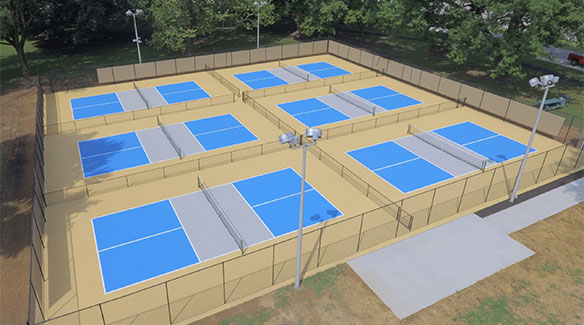Navigating Laws for Pickleball Court Building And Construction in Your Location
Building a pickleball court in your location calls for a nuanced understanding of different neighborhood regulations, including zoning laws, building licenses, and safety requirements. Involving with regional authorities and the neighborhood is crucial for making sure conformity and fostering support.
Recognizing Neighborhood Zoning Laws
When thinking about the building and construction of a pickleball court, understanding local zoning legislations is vital to ensuring compliance and preventing prospective lawful concerns. Zoning regulations dictate how land can be utilized and often include specs associated to entertainment centers. These regulations can differ significantly by municipality, impacting elements such as court placement, size, noise, and lighting levels.
Before initiating building, it is vital to seek advice from the neighborhood zoning board or preparation department to determine the particular regulations that put on your home. Specific zones might limit leisure activities, while others may require certain permits or adherence to specific standards. It is likewise crucial to take into consideration setbacks, which determine how far frameworks have to be from property lines or various other structures.
Additionally, private growths, such as house owner associations (HOAs), may enforce their own regulations relating to the building and use pickleball courts. Recognizing these policies can prevent pricey modifications or lawsuits down the line. Engaging with neighborhood stakeholders and neighborhood participants can offer valuable understandings and foster support for your job, ensuring that it lines up with the community's expectations and needs.
Acquiring Necessary Building Allows
How does one navigate the intricacies of getting necessary building licenses for a pickleball court? Commonly, you will need to submit an in-depth website strategy that details the recommended court measurements, materials, and layout.

As soon as permits are acquired, it is crucial to comply with any kind of inspection routines and demands throughout the building and construction phase. Maintaining communication with neighborhood authorities will certainly help with a smoother approval procedure and aid stay clear of possible problems. By completely preparing and recognizing the allowing landscape, you can successfully navigate the complexities included in building a pickleball court while continuing to be certified with all neighborhood regulations.

Assessing Environmental Impact
A thorough evaluation of ecological effect is essential when planning the building of a pickleball court. This assessment assists recognize prospective results on local environments, water sources, and community looks. Key elements to take into consideration consist of site choice-- making certain that the court is not improved ecologically sensitive land, such as marshes or environments for endangered types
Dirt security and drainage patterns ought to be examined to avoid erosion and water pooling, which could negatively impact bordering plant life and wildlife. Additionally, the choice of products is essential; selecting eco-friendly and sustainable options reduces environmental damage.
The application of efficient stormwater administration methods is one more essential facet, as it aids minimize drainage and sedimentation. Engaging with neighborhood environmental companies can supply beneficial understandings right into guidelines and finest methods certain to your area.
Finally, community input can be useful in comprehending any regional environmental Resources issues and fostering assistance for the task. By performing a complete ecological effect assessment, stakeholders can ensure that pickleball court construction aligns with sustainable techniques and contributes positively to the area's environmental health and wellness.
Complying With Safety Requirements
Making sure compliance with safety and security requirements is important for the successful building and construction and operation of a pickleball court. Following well established safety laws lessens the risk of crashes and injuries, ensuring a safe environment for gamers.
Key safety and security standards consist of proper court measurements, surface products, and lighting demands. The court must fulfill the main dimensions of 20 feet vast by 44 feet long for doubles play, with ideal buffer areas to stop injuries from wayward balls. Pickleball court construction. The surface area needs to be built from non-slip products to enhance traction and lower the possibility of drops
Additionally, illumination must be sufficient for night play, supplying consistent lighting to avoid darkness that can hinder exposure. Neighborhood building regulations may additionally dictate particular demands for fence and internet elevation to guarantee gamer safety and security and prevent unauthorized accessibility to the court location.
Normal examinations and upkeep are vital to promote these criteria over time. By prioritizing security compliance, court proprietors not just shield gamers yet also foster a positive track record within the area. This dedication to safety and security can urge greater participation and enjoyment of the sport, ultimately contributing to its growth and sustainability.

Engaging the Area in Planning
Neighborhood participation blog in the drawing board of pickleball court building can dramatically enhance the project's general success. Engaging local citizens and stakeholders promotes a feeling of possession and urges collaborative decision-making, which can result in wider assistance for the effort.
To properly entail the area, organizers should initiate public meetings or workshops, offering a platform for locals to voice their viewpoints and choices pertaining to location, design, and amenities. Surveys and feedback forms can also be utilized to gather insights from a wider audience, ensuring that varied viewpoints are taken into consideration.
In addition, creating a neighborhood board of advisers can assist in continuous discussions and address concerns throughout the preparation procedure. This board can consist of agents from various demographics, such as local colleges, leisure organizations, and neighborhood organizations, therefore magnifying neighborhood representation.
Reliable interaction is essential; updates about more helpful hints the task must be on a regular basis shared via newsletters, social media, or neighborhood publications. By prioritizing area interaction, planners can grow interest, mitigate possible opposition, and develop a pickleball facility that truly reverberates with local worths and requirements. This joint technique not only enhances the project yet also reinforces neighborhood connections.
Final Thought
To conclude, navigating the intricacies of pickleball court construction demands an extensive understanding of neighborhood laws, consisting of zoning laws, structure permits, and security standards. Carrying out ecological assessments is important to reduce eco-friendly impact, while neighborhood engagement can improve assistance for such tasks. By sticking to these guidelines and cultivating collaboration, successful execution of pickleball courts can be achieved, promoting leisure possibilities and community wellness. Proceeded persistance in these areas will make sure lasting and compliant growth.
Creating a pickleball court in your location calls for a nuanced understanding of numerous neighborhood laws, consisting of zoning regulations, structure authorizations, and safety and security criteria.When taking into consideration the building and construction of a pickleball court, recognizing regional zoning legislations is vital to making sure conformity and preventing prospective legal issues. By extensively preparing and recognizing the allowing landscape, you can effectively browse the intricacies included in creating a pickleball court while staying compliant with all local regulations.
In verdict, browsing the complexities of pickleball court construction demands a detailed understanding of regional regulations, consisting of zoning legislations, building permits, and safety and security requirements. By adhering to these standards and promoting collaboration, effective implementation of pickleball courts can be attained, promoting leisure opportunities and neighborhood wellness.